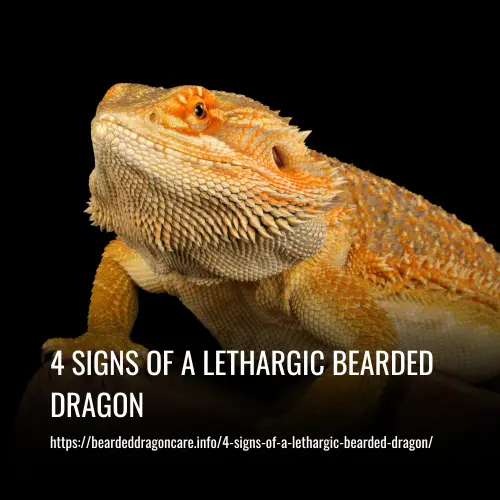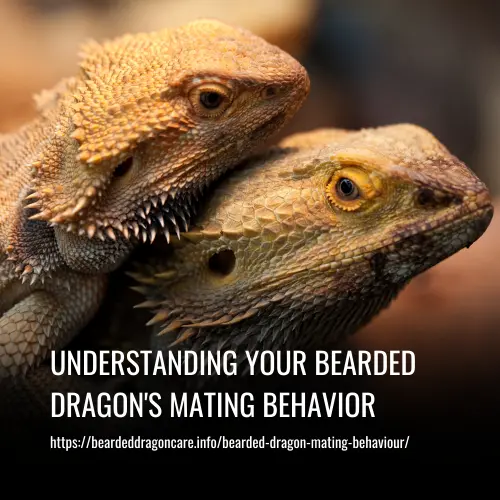Bearded dragons are incredibly popular pets worldwide. They have a very silly name, but they make fascinating pets with lots of personalities.
Underneath their scaly exteriors, there is a complex animal that many people don’t know a lot about. Did you know, for instance, that bearded dragons can change color depending on their environment and mood?
In this article, we’ll examine 30 interesting facts about bearded dragons. From how they communicate to the foods they eat, let’s take a look at some of the amazing facts about these adorable creatures!
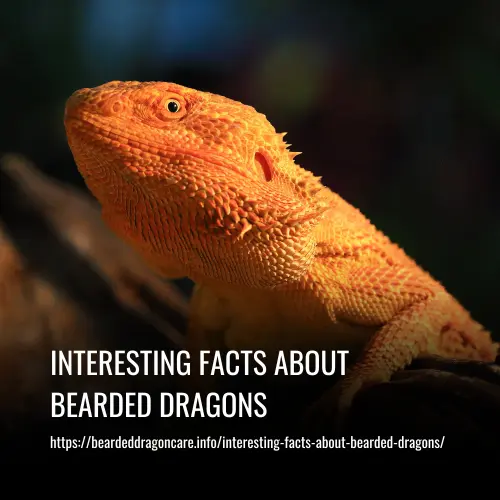
30 interesting facts about Bearded dragons
Originating from Australia, the captive-bred Bearded dragon makes for a gentle and friendly pet reptile. Here are 30 facts you probably didn’t know about Bearded dragons, and why you might strongly consider bringing one into your life and home.
1. Their name comes from the ‘beard’ of spiny scales around their necks
Bearded Dragons got their name from the spiny scales around their necks. These spines change color to black when they are opened as a mating call or defense mechanism. This gives these creatures the appearance of having a beard, hence their namesake.
2. They Wave To Acknowledge Each Other
Bearded Dragons sure are amazing! They not only recognize each other but also can wave to signify their acknowledgment. It’s fascinating to watch them interact with one another in this way, as it is an indication of what submission looks like in the face of a larger and more dominant dragon.
It’s even more incredible that these Lil guys will wave at their owners too! This serves as an indicator that they can also recognize humans and want to show their recognition of us in return. So cool!
3. They develop unique behaviors
Bearded dragons are truly amazing creatures and they develop some very unique behaviors. For starters, when they’re relaxing in their vivariums, you may have seen them as if they are sunbathing on the beach. It’s quite an adorable sight!
But even cuter is the trademark movement known as head bobbing — which both males and females do, usually during mating season when competing for mates or territory. In the wild, bearded dragons will even sunbathe together to display power and soak up more UV light.
It’s amazing how these little lizards have evolved over time to develop such interesting behaviors that help them survive and thrive in their natural environment!
4. They can run up to 9 miles per hour
Bearded dragons may look calm and sedentary, but they can actually reach incredible speeds! These lizards are capable of running up to 9mph, which makes them one of the fastest reptiles around. Not just that, they’re also one of the easiest lizards to train – so you can even take them on walks with you! Just be prepared – if your bearded dragon spots something it wants (like some food), it might shoot off without you in the blink of an eye. So you’d better be able to keep up.
5. They can swim
Bearded dragons are usually found in dry, arid areas but they can also have a good time in the water! Some will bask in shallow pools of water and use it as an escape from the heat, while others are surprisingly capable swimmers. In fact, some dragons are so confident in their swimming skills that they will contentedly paddle around for a bit.
They employ a technique known as inflation to help buoy their weight in the water and swim similarly to crocs with a jolting motion. This surprising ability to swim means that these reptiles can take full advantage of water sources if presented with them!
6. Their teeth grow back
Bearded dragons have an amazing ability to regenerate their teeth. They may lose their front teeth when trying to catch prey or tear apart food, but have no fear – they can grow them right back!
This unique feature of beardies means that you don’t have to worry if your dragon loses a tooth, as they’ll be able to get it back in no time. This amazing ability is not shared by other reptiles and is something special that bearded dragons possess.
7. They can sleep standing up
Bearded dragons have an impressive ability – they can sleep while standing up! It’s hard to believe, but it’s true – these reptiles are known to take naps while using their hind legs to stand. They will often lean against the walls of their vivarium or some furniture within it for more comfort.
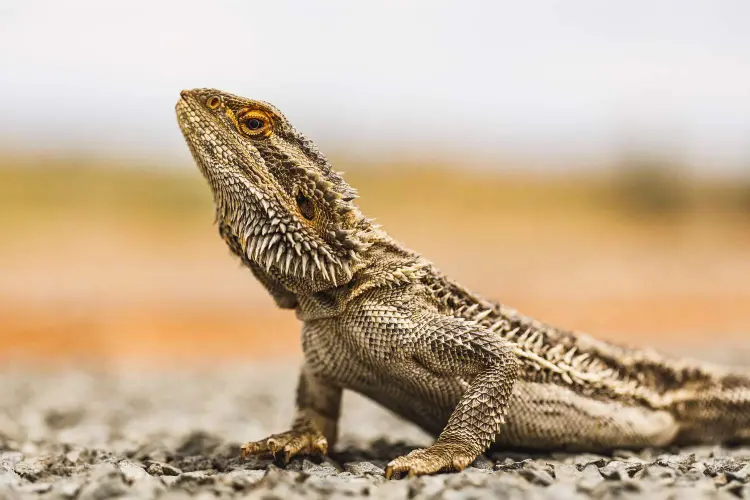
8. They can run on two legs
Bearded dragons have an impressive ability to run on two legs! It’s believed that the cause of this is an evolutionary fault, which allows them to move more rapidly and with more agility.
When running, the center of gravity in these lizards moves to the back of their body allowing them to get going at an impressive speed. As they accelerate, their front feet will leave the ground and they will continue running upright on just their hind legs!
9. Their scales tell their mood
Bearded dragons are truly amazing creatures, and if you know how to read them, their scales can say a lot about their mood. Rather than just the trademark puffed-out throats that we all associate with these wonderful reptiles, they also use their scales to express emotions.
When they’re feeling stressed, the scales around their bodies will become tense and spiky. When relaxed, their scales will lay flat and feel smooth to the touch. Not only that, but they may even change color – if they are feeling threatened or stressed out, or preparing for mating season, the beard of your bearded dragon may darken in color.
10. They can change color
Bearded dragons have the remarkable ability to change their skin color, although it might not be something that is as obvious as in other reptiles like chameleons. Throughout their lifetime, they shed their skin and when they do, it’s sometimes a different color than before.
Furthermore, bearded dragons will also change colors depending on their temperature. To stay warm, these reptiles will darken their scales, and to keep cool, they will lighten them up to minimize the amount of heat absorbed. Bearded dragons can vary in color, depending on their breed. This color range includes oranges, yellows, browns, and even greens!
11. Bearded Dragons Can Climb Trees
Bearded dragons are amazing creatures that can even climb trees! While they might be mostly terrestrial, they’re still capable of becoming expert tree climbers when they need to. This could be when there’s food unavailable at ground level or when a predator is chasing them.
Plus, since they love basking in the sun, they’ll often climb trees just to find the perfect spot with lots of sunlight or bask at a higher level than another bearded dragon. That’s their way of demonstrating dominance!
12. They Collect Water on Their Heads
Bearded dragons are known for their quirky ways to capture and store water in the incredibly dry desert environment. One method that members of the Pogona genus have been seen doing is collecting water on their own heads when it rains.
These lizards stand on their hind legs with their head tilted downward, so that the water can run directly down their faces for up to half an hour as they lap it up! This impressive adaptation helps them stay hydrated as much as possible during these rare instances of rainfall in the desert. It’s amazing how these reptiles have figured out such a unique way to survive even in harsh conditions.
13. Females Can Store Sperm for Later
Bearded dragons are special in that females have the unusual ability to store sperm for later use. After mating just once, female bearded dragons can lay two clutches of 11 to 30 eggs during each breeding season and even fertilize them themselves by using the stored sperm.
This is an incredible advantage, as it means she can maximize her offspring production without having to rely on continued matings with a potentially violent male who has a tendency to bite her neck. On top of this, they come into sexual maturity at one to two years of age. Truly remarkable!
14. Male Beardies Become Females in Warm Temperatures
It has been discovered that male bearded dragons can become female under one specific condition: when they are exposed to temperatures of 96.8 degrees and higher during embryonic development. This transition to femininity happens 100% of the time under these conditions. Not only that, but these female ex-males (trans beardies) are capable of producing twice as many eggs as non-trans females!
These stunning findings have implications in terms of how climate change affects the reptile’s ability to adapt to new conditions. With global temperatures rising, male beardies becoming females may just become even more common. As a result, this strange process could be very detrimental to population stability in the long run if environmental conditions keep getting warmer and warmer.
15. They Like Their Alone Time
Bearded dragons are solitary creatures that enjoy their alone time. Though in the wild they may live in colonies consisting of one male and multiple females, it’s not recommended to keep them together under captivity. In fact, putting two or more bearded dragons together can be quite challenging as it can lead to fights among themselves.
So if you’re a bearded dragon keeper, don’t worry! Your scaly friend is perfectly content living by itself and doesn’t need another companion. Bearded dragons like their alone time, so it’s best to give them plenty of space and solitude to thrive in their environment.
16. They Pee Powder
The bearded dragon is truly an amazing animal. One of its strangest traits is the way it pees. Rather than giving off liquid, it excretes a white powdery substance called “urate” that looks like chalk paste.
This is because of the creature’s evolution in order to hold on to more water while living in the hot and arid environment of Australia. It passes this urate through its cloaca, which is also responsible for passing fecal matter. Truly fascinating!
17. Bearded Dragons Brumate in the Winter
Bearded dragons are known to brumate in the winter, a process that is similar to hibernation. From around November, they will become sluggish and lose their appetite- this is the beginning of their brumation period, where their heart rate, body temperature, and metabolism will all drastically reduce to conserve energy. In the wild, beardies go into brumation as early as June when winter hits Australia.
18. They Love To Sunbathe
Bearded Dragons are very much lovers of sunbathing. Their cold-blooded nature means they need to get their body heat from outside sources, so it’s no surprise that they love to soak up the sun!
During the day, you’ll often catch them basking in its rays – some like to be solo, while others will display dominance by laying on top of one another in order to expose more of their bodies to the warmth of the sunshine. It’s a sight that never fails to bring a smile to one’s face.
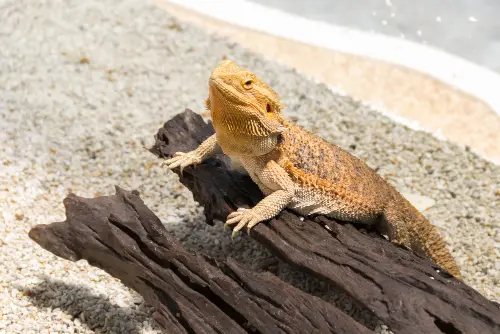
19. They Love Going On Walks On A Leash
Bearded Dragons are actually quite easy to train to go on a leash! While it might seem a bit strange, walking them outside on a leash can be an incredibly stimulating activity for them. Not only that, but you’re sure to get some interesting looks as you stroll with your dragon companion on a leash.
20. They Make A Hissing Noise When Defending Territory
Bearded Dragons are known for making a hissing noise when defending territorial issues. This is their way of asserting dominance over the other dragon. When they are feeling threatened, the beardie will puff out its beard and then let out a long hiss in order to make sure the opponent knows they mean business.
21. Bearded dragons are relatively new pets
Bearded dragons weren’t popular pets until around the 1990s. In South Africa, Bearded dragons became popular in about 1995. Since their introduction, they have flourished as pets and are now among the top 5 most kept reptiles (only surpassed by Leopard geckos, Corn snakes, and Ball pythons) in the world.
22. Bearded dragons are docile by nature
Bearded dragons are considered to be one of the most easy-going and relaxed pets in the reptile world. Many keepers allow their Bearded dragons to sit on their lap and allow them to wander outside in the garden or on the grass. They are easy to leash train and will even casually allow their owners to dress them in clothing.
23. Bearded dragons are still wild at heart
Because of their docile and calm nature, the domestication of Bearded dragons didn’t take long. Although you might find a wild-acting Bearded dragon from time to time, most are naturally easy to keep and handle. Even in nature, there are a lot of reports where people simply walked toward a Bearded dragon and picked it up.
24. It’s all in the beard
Bearded dragons got their name from the spiny projections under their necks that resemble a man’s beard. The beard area, also called the guller area, can be inflated during conflict or mating behavior. This is to make them look bigger and more fearsome. Contrary to popular belief, the spines of Bearded dragons are actually non-prickly and soft to the touch.
25. Bearded dragons make interesting pets
Apart from being hardy and docile, Bearded dragons make very interesting pets. With their many different behaviors and mannerisms, they are a pleasure to observe and interact with. Bearded dragons are diurnal by nature, meaning they are most active during the day. Almost every Bearded dragon can have its own personality and will respond differently when it is time for eating, sleeping, hunting, and relaxing.
26. Bearded dragons are omnivores
Although crickets are the most commonly fed food, Bearded dragons are actually considered omnivores. This means they can eat and survive on both meat and plant materials. As pets, Bearded dragons can eat many things other reptiles cannot – including insects, small vertebrates, fruit, vegetables, and even leaves and flowers. Also, see what greens to feed Bearded dragons and foods not to feed to Bearded dragons for more information.
27. Bearded dragons are proliferous breeders
Bearded dragons are proliferous by nature and successful breeders. Breeding with Bearded dragons is easy and in most cases even unstoppable. A female Bearded dragon can lay between 20 to 30 eggs per clutch, 3 to 5 times per year. Also, see Bearded dragon breeding for more information.
28. Bearded dragons like to climb
In nature, one would often find a Bearded dragon sitting high up on rocks. They are also often found in small trees, on fence posts, and on walls. This is to allow them the maximum amount of sun rays to be able to bask and absorb ultraviolet rays. Also, see Bearded dragon basking behavior and Bearded dragon UV lighting for more information.
29. Bearded dragons shed their skins regularly
Just like mythical dragons, a Bearded dragon’s skin is covered with dry scales – some spikey, some flat. As a Bearded dragon grows, the older, outer skin later need to make way for the newer, larger layers. In Bearded dragons, the skin is usually shed in patches, unlike in snakes, where the skin is usually shed in one piece.
30. Long live the Bearded dragon
As pets, Bearded dragons can live up to 10 years. When it comes to life span, this puts them in the same category as domesticated dogs. Although this is true, longevity is still dependent on a healthy lifestyle, prevention, and treatment of disease, the correct variation of food, proper lighting, and supplementation.
FAQs
Do bearded dragons have 3 eyes?
Believe it or not, bearded dragons possess a third eye which is located on the top of their head. Even though this eye works differently than the other two eyes, it plays an essential role in the bearded dragon’s life and survival.
Do bearded dragons cry?
Bearded dragons and other reptiles cry tears to clean and maintain their eyes, not out of sadness – it’s a biological process for them.
Can a bearded dragon get pregnant by itself?
A female bearded dragon living on its own can still lay eggs, either due to recent contact with a male or because it isn’t uncommon for females of some species, including dragons, to produce infertile eggs without being near a male.
Conclusion
In conclusion, bearded dragons are exciting and fascinating animals that make great pets for reptile lovers. They have their own unique personalities that you can get to know as you spend more time with them.
Learning about their habitat and behaviors helps us gain a better understanding of the species and how to help keep them happy and healthy in the long run.
